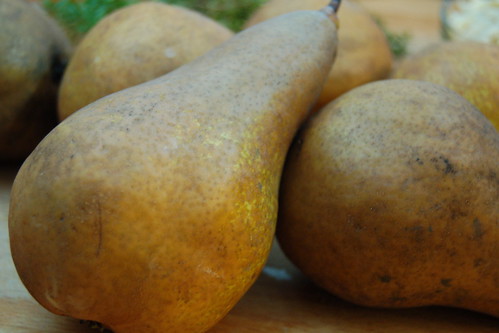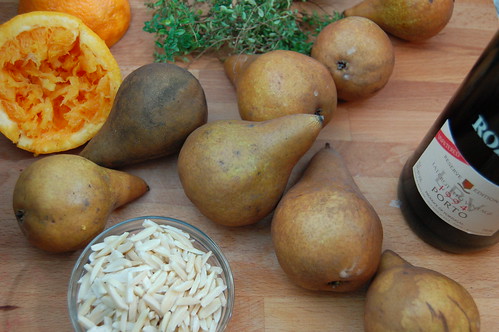What I have figured out is where this sweet and aromatic condiment goes: IN MY BELLY. Like I said, I've made it twice. The first time I got five half-pint jars out of it, but the second time I only got four... partly because I used slightly fewer pears and partly because I ate so much while it was cooking.
Pear, Port & Thyme Conserve
adapted from Well Preserved
So it turns out a conserve is defined by the presence of raisins and nuts. This one calls for slivered almonds and golden raisins, but if you only have the regular purple kind I don't think it will make much difference flavor-wise. It may affect the color.
Makes 4-5 half pint jars
1/2 cup golden raisins
1/2 cup light brown sugar
1/2 cup fresh squeezed orange juice (see note, below)
1/4 cup bottled lemon juice (see note, below)
1 tablespoon grated lemon zest
1/2 teaspoon cinnamon
1/2 teaspoon nutmeg
1/2 teaspoon ground ginger (the spice powder, not the root)
pinch of salt (I used 1/4 teaspoon)
3 pounds Bosc or Anjou pears, peeled, cored and coarsely chopped (they don't break down much so don't leave any huge chunks)
1/2 cup sliced blanched almonds
1/4 cup port wine
1 tablespoon chopped fresh thyme (lemon thyme is very nice here)
Note: Total amount of juice is 3/4 cup. When I juiced one orange and only got between 1/3 and half a cup of juice, not the full 1/2 cup called for, I just poured bottled lemon juice in until I hit the 3/4 cup mark. I like acidity though, and I didn't have a backup orange.
If you're planning to hot-water-bath can these*, bring a large pot of water to a boil with a rack on the bottom of the pot. I usually put my empty jars (without the lids) in the rack while the water comes up to temperature, that way they've been sterilized by the time the preserve is cooked and ready to be canned. Heat the lids in a small pot of simmering (not boiling) water to soften the flange.
Combine the raisins, brown sugar, orange and lemon juices, lemon zest, cinnamon, nutmeg, ginger and salt in a large pot over medium high -heat. Stir to dissolve the sugar while the mixture comes up to a boil. Add the pears, lower the heat, and cover the pot. Let it simmer on low for 15 minutes. Remove the cover so it starts to thicken up, and cook another 15 minutes, stirring occasionally.
*Precise, exlicit instructions for water bath preserving are available from Canning Across America or the National Center for Home Food Preservation. The Ball Blue Book of Preserving is also a great basic resource for methods and recipes.
.jpg)



Mmmmmm... that sounds awesome! I made a quince "chutney" this weekend that sounds an awful lot like this. It was delicious with roasted chicken. And I think it's conSERvuh, but I speak German, so you probably shouldn't listen to me :-)
ReplyDeleteI've never had anything like this. Sounds amazing!
ReplyDeletewow, this sounds scrumptious, but i'd totally say it wrong :)
ReplyDeleteLovely flavor profile!
ReplyDeleteYou had the emphasis right the first time: ConSEEHRve. :)
Thanks, Aimee! I will trust the Montrealer with my French pronunciation questions :)
ReplyDelete